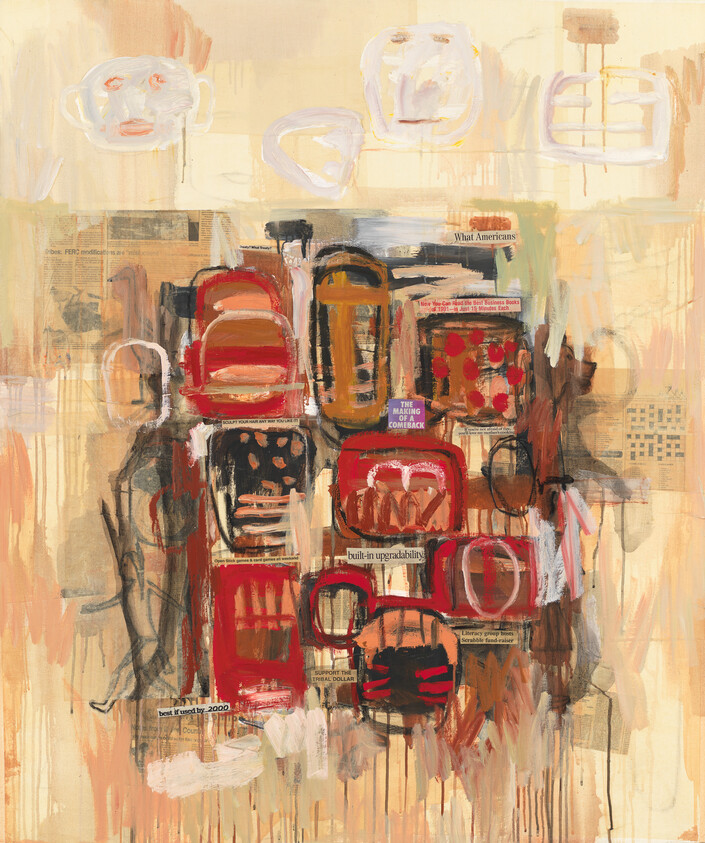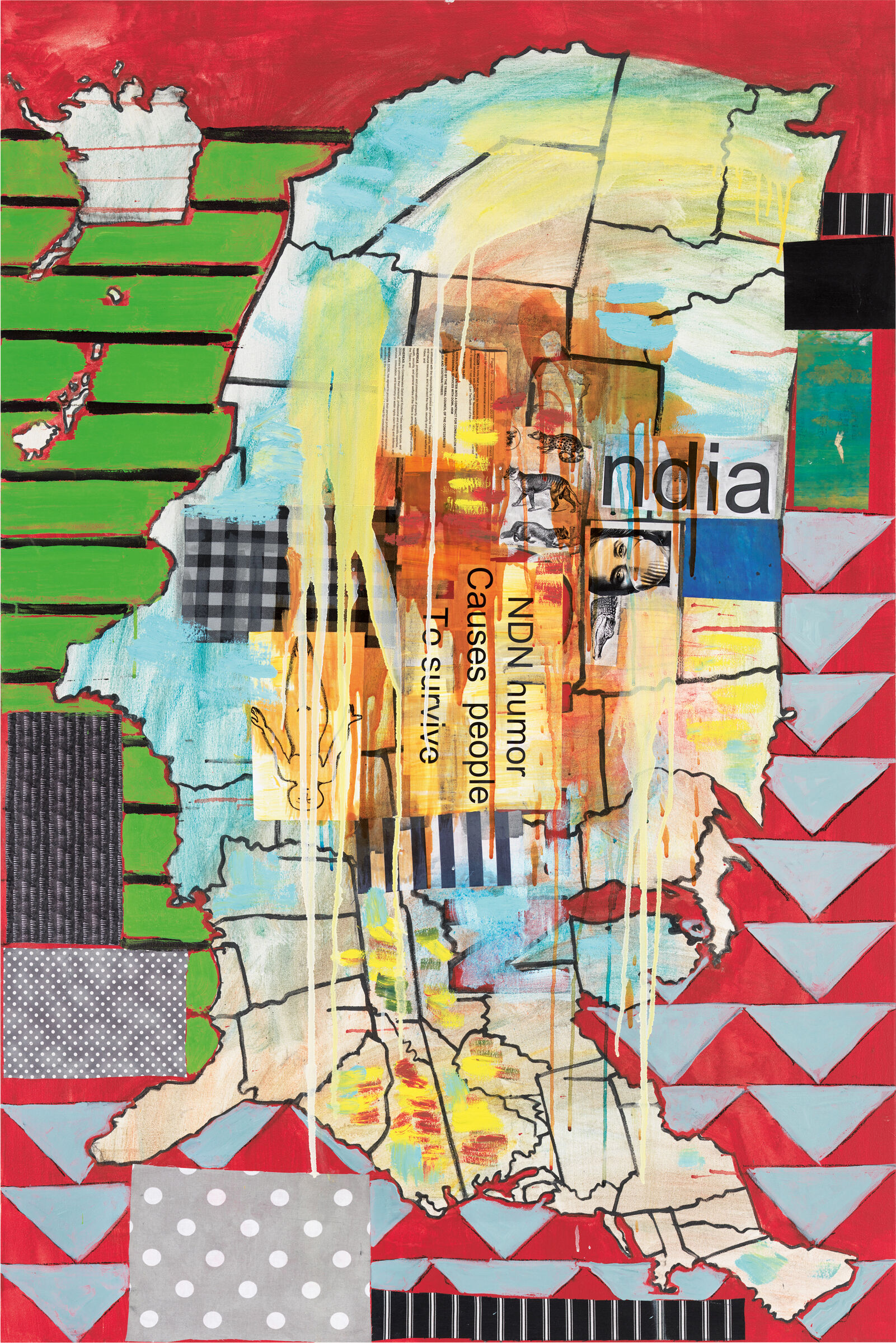Visual description
The Vanishing American is a vertical mixed media painting on canvas measuring about 60 inches high by 50 inches wide. In the middle and slightly towards the bottom of the painting is a cluster of head-like shapes interspersed with marks and newspaper clippings. The cluster is primarily red, orange, brown, black, and is surrounded by beige, pale pink, tan and white colored painterly marks, which peek through the cluster and drip down the canvas surrounding the cluster. The top one quarter section of the painting contains what appears to be a row of four faces painted loosely in white with ambiguous paired down features. The bold colored cluster underneath contains many square shapes with rounded corners. Some are painted with a black or white thin outline or thicker red outline, and some are filled in with dots or horizontal lines. Long and short, horizontal, vertical and zigzag strokes fill and surround the rounded shapes and their darker colors drip down the bottom of the canvas. Emerging from the edges of the cluster is the outline of three figures. Coming from the top right edge appears to be the side profile of a brown bear. Coming from the top left edge is a black outline of a bird with a long neck and long legs, obscured by vertical strokes of beige paint and a white oval and coming from the bottom left is a black outline of a person with their arms and legs outstretched as if running or in motion.
The newspaper clippings that are placed throughout the cluster are various sizes; some are a few words while others are longer text. Four clippings of longer text peek out from underneath washes and drips of paint by the edges of the cluster. Visible text on the top right clipping by the bird reads “Tribes: FERC modifications are “misfocused”. A clipping by the bear reads “Advisory Deadline” next to a crossword puzzle. Paragraphs of small text peek out through the bottom right corner. Coming out from underneath the running figure are thicker paint drips and brush strokes that read “Notes from Indian Country,” which, along with the crossword puzzle clipping, have a newspaper header featuring several tipis. The visible text from the clippings scattered across the black, brown and warm colored cluster from top to bottom reads “What Americans”, “Treaty? What Treaty?”, “If you’re not afraid of fire, you’ll love my mother’s cooking”, “Open Stick games & card games all weekend”, “built-in upgradability”, “Literacy group hosts Scrabble fundraiser”, “SUPPORT THE TRIBAL DOLLAR”, and “best if used by 2000”. The small square clipping reading “The making of a comeback” in particular sticks out with its contrasting blue-purple gradient background.
The title of the work, The Vanishing American, is a pointed critique of the notion that Native American people and culture have been dispersed and diminished. Quick-to-See Smith takes the idea and turns it on its head: instead imagining the disappearance of white America. About this work, she has said: “the culture's changing…this is what’s happening, the Browning of America.”
Not on view
Date
1994
Classification
Paintings
Medium
Acrylic, paper, cotton, printing ink, fabricated chalk, and graphite pencil on canvas
Dimensions
Overall: 60 1/8 × 50 1/8 in. (152.7 × 127.3 cm)
Accession number
2007.88
Credit line
Gift of Dorothee Peiper-Riegraf and Hinrich Peiper in memory of Arlene LewAllen
Rights and reproductions
Courtesy the artist and the Garth Greenan Gallery, New York
Audio
-
0:00
Verbal Description: The Vanishing American, 1994
0:00
Narrator: The Vanishing American is a vertical mixed media painting on canvas measuring about 60 inches high by 50 inches wide. In the middle and slightly towards the bottom of the painting is a cluster of head-like shapes interspersed with marks and newspaper clippings. The cluster is primarily red, orange, brown, black, and is surrounded by beige, pale pink, tan and white colored painterly marks, which peek through the cluster and drip down the canvas surrounding the cluster. The top one quarter section of the painting contains what appears to be a row of four faces painted loosely in white with ambiguous paired down features. The bold colored cluster underneath contains many square shapes with rounded corners. Some are painted with a black or white thin outline or thicker red outline, and some are filled in with dots or horizontal lines. Long and short, horizontal, vertical and zigzag strokes fill and surround the rounded shapes and their darker colors drip down the bottom of the canvas. Emerging from the edges of the cluster is the outline of three figures. Coming from the top right edge appears to be the side profile of a brown bear. Coming from the top left edge is a black outline of a bird with a long neck and long legs, obscured by vertical strokes of beige paint and a white oval and coming from the bottom left is a black outline of a person with their arms and legs outstretched as if running or in motion.
The newspaper clippings that are placed throughout the cluster are various sizes; some are a few words while others are longer text. Four clippings of longer text peek out from underneath washes and drips of paint by the edges of the cluster. Visible text on the top right clipping by the bird reads “Tribes: FERC modifications are “misfocused”. A clipping by the bear reads “Advisory Deadline” next to a crossword puzzle. Paragraphs of small text peek out through the bottom right corner. Coming out from underneath the running figure are thicker paint drips and brush strokes that read “Notes from Indian Country,” which, along with the crossword puzzle clipping, have a newspaper header featuring several tipis. The visible text from the clippings scattered across the black, brown and warm colored cluster from top to bottom reads “What Americans”, “Treaty? What Treaty?”, “If you’re not afraid of fire, you’ll love my mother’s cooking”, “Open Stick games & card games all weekend”, “built-in upgradability”, “Literacy group hosts Scrabble fundraiser”, “SUPPORT THE TRIBAL DOLLAR”, and “best if used by 2000”. The small square clipping reading “The making of a comeback” in particular sticks out with its contrasting blue-purple gradient background.
The title of the work, The Vanishing American, is a pointed critique of the notion that Native American people and culture have been dispersed and diminished. Quick-to-See Smith takes the idea and turns it on its head: instead imagining the disappearance of white America. About this work, she has said: “the culture's changing…this is what’s happening, the Browning of America.”
-
0:00
The Vanishing American, 1994
0:00
Narrator: Smith called this painting The Vanishing American. It mixes brushy abstraction with headlines clipped from newspapers. In the upper right, one reads “What Americans,” pointing loosely to the painting’s ironic explorations of identity.
Jaune Quick-to-See Smith: See there's always this thing about "the vanishing Native American." The vanishing American Indian. And we've been hit with that all of our lives. That, "oh you guys are so watered down." "Oh you guys are so mixed blood, you don't know who you are." "Oh you're so bastardized, you have no culture left."
Narrator: Smith said she was inspired to make the painting after a community meal during medicine lodge ceremonies on the lands of the Blackfeet Nation, near her childhood home.
Jaune Quick-to-See Smith: And then when everybody would gather to eat, people would start talking about, “And, you know, the white people are just going to do themselves in with all their poisons and all the pesticides and everything that they're using on our food. And so they're just going to be the vanishing white men.” And then everybody would laugh.
So I came back into the studio, and here I found this sign called built-in upgradability out of some New York Times or some ad or something. And I said, yeah, that really fits what the elders are saying, that we're going to make it through this. Built-in upgradability, that's what we have. We've been here for thousands and thousands of years. They just got here yesterday. They keep pretending like, oh, we just got here before them. Well, that's not true. We've been here since the creation time. So the making of a comeback.
Installation photography
-


Installation view of Jaune Quick-to-See Smith: Memory Map (Whitney Museum of American Art, New York, April 19-August 13, 2023). From left to right: Worlds within Words, 1996; What is an American?, 2003; The Vanishing American, 1994; The Vanishing White Man, 1992; Grasp Tight the Old Ways, 2011. Photograph by Ron Amstutz
From the exhibition Jaune Quick-to-See Smith:<br>Memory Map


